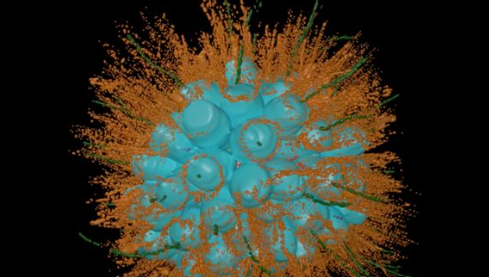Scientists from the University of California, Berkeley, have discovered a remarkable microorganism in Mono Lake’s harsh environment, offering new insights into the origins of multicellular life. This microscopic organism, a choanoflagellate named Barroeca monosierra, was found in the lake’s saline waters, known for its unique and extreme conditions. Choanoflagellates are single-celled organisms that share a close evolutionary relationship with animals, making them a crucial model for studying the transition from unicellular to multicellular life.
❤️Microscopic Creature Discovered in California’s Mono Lake https://t.co/Vwrui0ySCS
— Financial News (@TeamFNews) August 23, 2024
What makes B. monosierra particularly fascinating is that it harbors its own microbiome—the first choanoflagellate ever found to maintain a stable relationship with bacteria. Traditionally, choanoflagellates are known to consume bacteria, not coexist with them. This discovery challenges previous assumptions and opens up new avenues for understanding how early life forms might have interacted with their environments and other organisms.
The discovery began nearly a decade ago when a UC Berkeley graduate student collected a sample of water from Mono Lake, which revealed colonies of choanoflagellates under the microscope. These colonies, consisting of nearly 100 identical cells, formed a hollow, spherical structure that exhibited a complex interaction with bacteria—something that had never been observed before in such organisms.
Further research revealed that the bacteria within the choanoflagellate colonies were not merely remnants of a meal but were thriving, growing, and dividing. This suggests a possible symbiotic relationship, where the bacteria might either be finding refuge from the toxic lake environment or perhaps being “farmed” by the choanoflagellates as a food source. However, much of this remains speculative, and future studies are needed to uncover the exact nature of this interaction.
The discovery of B. monosierra adds to the growing list of model systems that researchers like Nicole King, a professor at UC Berkeley, are using to study evolution. This choanoflagellate could provide valuable insights into the interactions between early eukaryotic organisms and bacteria, which may have played a significant role in the evolution of complex life.
Researchers from @berkeleyMCB have found an unusual creature lurking in the briny shallows of Mono Lake in the Eastern Sierra Nevada — one that could tell scientists about the origin of animals more than 650 million years ago. https://t.co/fCBXQrtpVP
— UC Berkeley (@UCBerkeley) August 22, 2024
However, obtaining more samples from Mono Lake may prove challenging, as recent visits have shown that these microorganisms are not consistently present. Despite this, the discovery of B. monosierra represents a significant milestone in understanding the microbial life of Mono Lake and its potential implications for evolutionary biology.
Key Points:
i. Researchers discovered a new choanoflagellate species, Barroeca monosierra, in Mono Lake.
ii. B. monosierra is the first choanoflagellate known to harbor its own microbiome, suggesting a unique symbiotic relationship with bacteria.
iii. The discovery challenges previous assumptions about choanoflagellates and opens new avenues for studying the evolution of multicellular life.
iv. The organism’s interaction with bacteria may provide insights into early eukaryotic life and the development of complex life forms.
v. Further research is needed to understand the full implications of this discovery and the role of B. monosierra in the broader ecosystem of Mono Lake.
TL Holcomb – Reprinted with permission of Whatfinger News



